Yazd Qanats
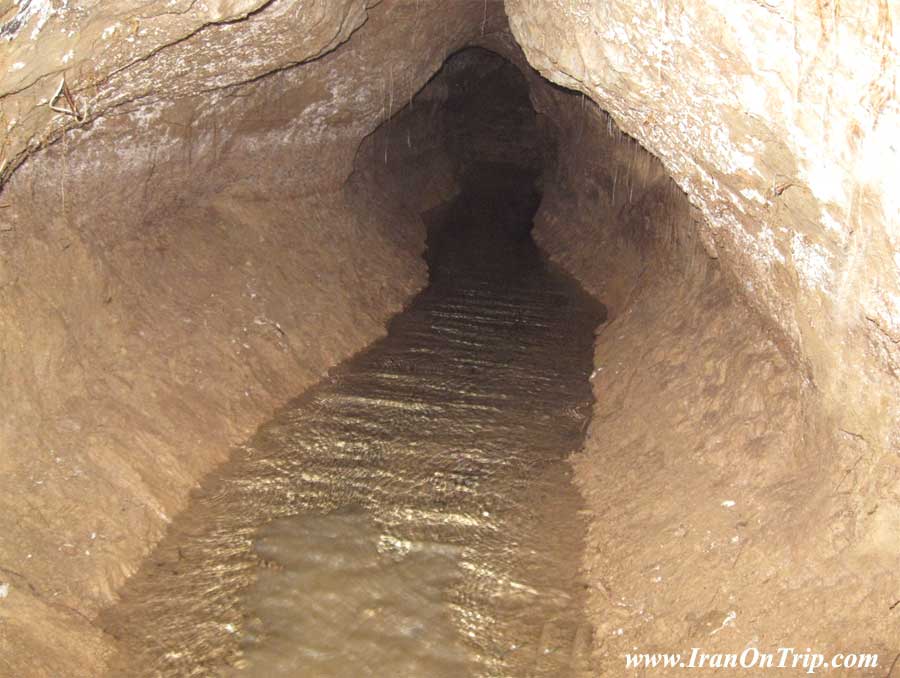
A qanāt (Arabic: قناة, Persian: قنات) is one of a series of well-like vertical shafts, connected by gently sloping tunnels. Qanāts create a reliable supply of water for human settlements and irrigation in hot, arid, and semi-arid climates.The qanat technology is known to have been developed by the Persian people sometime in the early 1st millennium BC and spread from there slowly westward and eastward.The value of the qanat is directly related to the quality, volume, and regularity of the water flow. Much of the population of Iran and other arid countries in Asia and North Africa historically depended upon the water from qanats; the areas of population corresponded closely to the areas where qanats are possible. Although a qanat was expensive to construct, its long-term value to the community, and thereby to the group that invested in building and maintaining it, was substantial.
Qanat's System
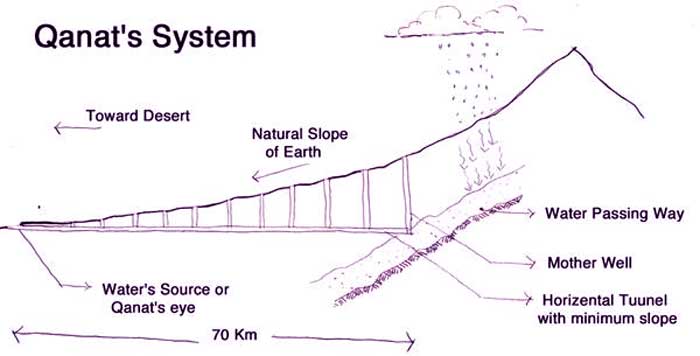
The most important problem in the desert, as we all know, is water. So they had to find a way to bring water to the city, without any kind of modern technology or pumping system.A passive system "Qanat" is used there. A mother-well was dug in a place far from the city where they could reach to the water table maybe 100 meters underground, they dug other wells to direct water toward the city, with minimum possible gradient. Using the slope of the earth they could bring water close to the surface in the city. It can be seen more clearly in the figure below.
Etymology
Qanats are also called kārīz (or kārēz from Persian: كاريز) (Iran, Afghanistan, Pakistan and Central Asia, derived from Persian: كاهریز), kahan (from Persian: کهن), kahriz/kəhriz (Azerbaijan); khettara (Morocco); galería (Spain); falaj (United Arab Emirates and Oman); Kahn (Baloch) or foggara/fughara (North Africa). Alternative terms for qanats in Asia and North Africa are kakuriz, chin-avulz, and mayun. Common variants of qanat in English include kanat, khanat, kunut, kona, konait, ghanat, ghundat.
Technical features
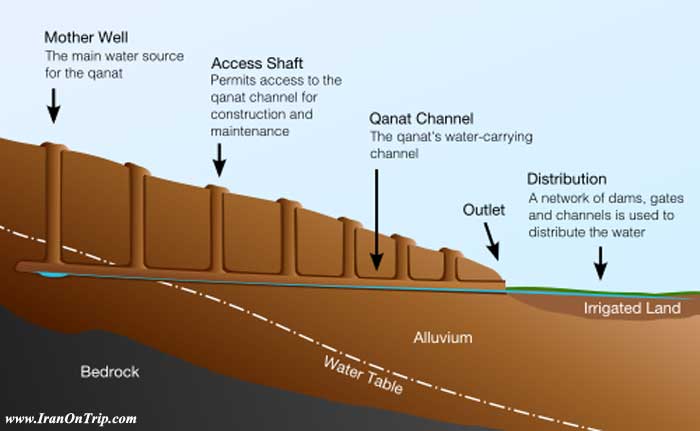
Qanats are constructed as a series of well-like vertical shafts, connected by gently sloping tunnels. Qanats tap into subterranean water in a manner that efficiently delivers large quantities of water to the surface without need for pumping. The water drains by gravity, with the destination lower than the source, which is typically an upland aquifer. Qanats allow water to be transported over long distances in hot dry climates without loss of much of the water to evaporation.
It is very common in the construction of a qanat for the water source to be found below ground at the foot of a range of foothills of mountains, where the water table is closest to the surface. From this point, the slope of the qanat is maintained closer to level than the surface above, until the water finally flows out of the qanat above ground. To reach an aquifer, qanats must often extend for long distances.
Qanats are sometimes split into an underground distribution network of smaller canals called kariz. Like qanats, these smaller canals are below ground to avoid contamination. In some cases water from a qanat is stored in a reservoir, typically with night flow stored for daytime use. An Ab Anbar is an example of a traditional qanat-fed reservoir for drinking water in Persian antiquity.The qanat system has the advantage of being resistant to natural disasters such as earthquakes and floods, and to deliberate destruction in war. Furthermore, it is almost insensitive to the levels of precipitation, delivering a flow with only gradual variations from wet to dry years.
Features common to regions that use qanat technology
The qanat technology is used most extensively in areas with the following characteristics.
• An absence of larger rivers with year-round flows sufficient to support irrigation
• Proximity of potentially fertile areas to precipitation-rich mountains or mountain ranges
• Arid climate with high surface evaporation rates so that surface reservoirs and canals would result in high losses
• An aquifer at the potentially fertile area which is too deep for convenient use of simple wells
Impact of qanats on settlement patterns
A typical town or city in Iran, and elsewhere where the qanat is used, has more than one qanat. Fields and gardens are located both over the qanats a short distance before they emerge from the ground and below the surface outlet. Water from the qanats defines both the social regions in the city and the layout of the city.
The water is freshest, cleanest, and coolest in the upper reaches and more prosperous people live at the outlet or immediately upstream of the outlet. When the qanat is still below grade, the water is drawn to the surface via water wells or animal driven Persian wells. Private subterranean reservoirs could supply houses and buildings for domestic use and garden irrigation as well. Further, air flow from the qanat is used to cool an underground summer room (shabestan) found in many older houses and buildings.
Downstream of the outlet, the water runs through surface canals called jubs (jūbs) which run downhill, with lateral branches to carry water to the neighborhood, gardens and fields. The streets normally parallel the jubs and their lateral branches. As a result, the cities and towns are oriented consistent with the gradient of the land; this is a practical response to efficient water distribution over varying terrain.The lower reaches of the canals are less desirable for both residences and agriculture. The water grows progressively more polluted as it passes downstream. In dry years the lower reaches are the most likely to see substantial reductions in flow.
Construction
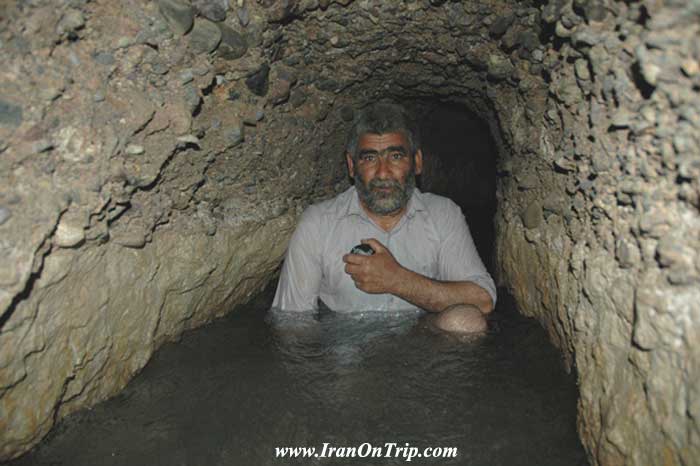
Traditionally qanats are built by a group of skilled laborers, muqannīs, with hand labor. The profession historically paid well and was typically handed down from father to son.
Preparations
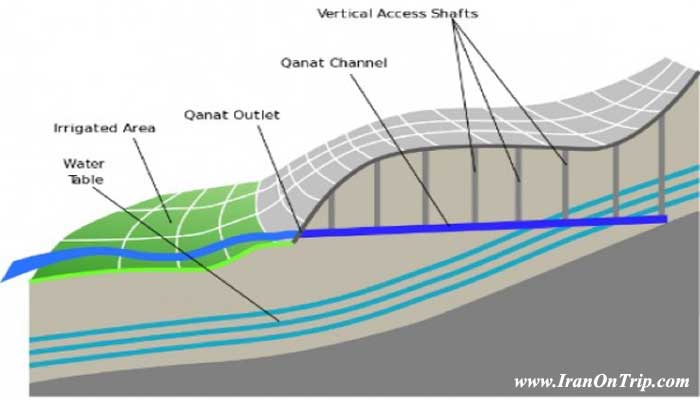
The critical, initial step in qanat construction is identification of an appropriate water source. The search begins at the point where the alluvial fan meets the mountains or foothills; water is more abundant in the mountains because of orographic lifting and excavation in the alluvial fan is relatively easy. The muqannīs follow the track of the main water courses coming from the mountains or foothills to identify evidence of subsurface water such as deep-rooted vegetation or seasonal seeps. A trial well is then dug to determine the location of the water table and determine whether a sufficient flow is available to justify construction. If these prerequisites are met, the route is laid out aboveground.Equipment must be assembled. The equipment is straightforward: containers (usually leather bags), ropes, reels to raise the container to the surface at the shaft head, hatchets and shovels for excavation, lights, spirit levels or plumb bobs and string. Depending upon the soil type, qanat liners (usually fired clay hoops) may also be required.Although the construction methods are simple, the construction of a qanat requires a detailed understanding of subterranean geology and a degree of engineering sophistication. The gradient of the qanat must be carefully controlled: too shallow a gradient yields no flow and too steep a gradient will result in excessive erosion, collapsing the qanat. And misreading the soil conditions leads to collapses, which at best require extensive rework and at worst are fatal for the crew.
Excavation
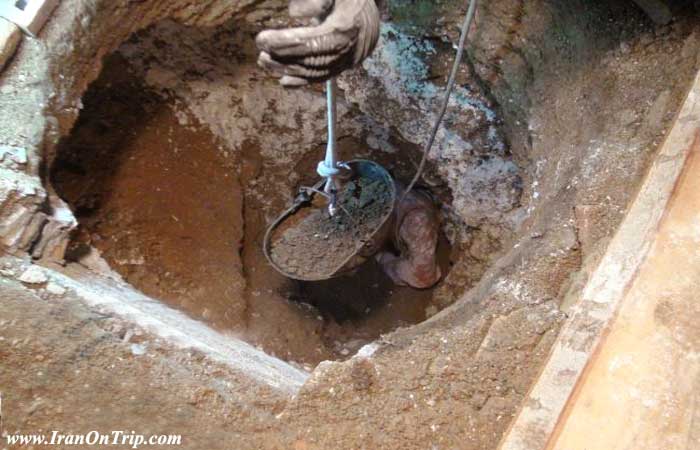
Construction of a qanat is usually performed by a crew of 3-4 muqannīs. For a shallow qanat, one worker typically digs the horizontal shaft, one raises the excavated earth from the shaft and one distributes the excavated earth at the top.The crew typically begins from the destination to which the water will be delivered into the soil and works toward the source (the test well). Vertical shafts are excavated along the route, separated at a distance of 20–35 m. The separation of the shafts is a balance between the amount of work required to excavate them and the amount of effort required to excavate the space between them, as well as the ultimate maintenance effort. In general, the shallower the qanat, the closer the vertical shafts. If the qanat is long, excavation may begin from both ends at once. Tributary channels are sometimes also constructed to supplement the water flow.
Most qanats in Iran run less than 5 km, while some have been measured at ~70 km in length near Kerman. The vertical shafts usually range from 20 to 200 meters in depth, although qanats in the province of Khorasan have been recorded with vertical shafts of up to 275 m. The vertical shafts support construction and maintenance of the underground channel as well as air interchange. Deep shafts require intermediate platforms to simplify the process of removing spoil.
The construction speed depends on the depth and nature of the ground. If the earth is soft and easy to work, at 20 meters depth a crew of four workers can excavate a horizontal length of 40 meters per day. When the vertical shaft reaches 40 meters, they can excavate only 20 meters horizontally per day and at 60 meters in depth this drops below 5 horizontal meters per day. In Algeria, a common speed is just 2 m per day at 15 m depth. Deep, long qanats (which many are) require years and even decades to construct.The excavated material is usually transported by means of leather bags up the vertical shafts. It is mounded around the vertical shaft exit, providing a barrier that prevents windblown or rain driven debris from entering the shafts. These mounds may be covered to provide further protection to the qanat. From the air, these shafts look like a string of bomb craters.
The qanat's water-carrying channel must have a sufficient downward slope that water flows easily. However the downward gradient must not be so great as to create conditions under which the water transitions between supercritical and subcritical flow; if this occurs, the waves that result can result in severe erosion that can damage or destroy the qanat. In shorter qanats the downward gradient varies between 1:1000 and 1:1500, while in longer qanats it may be almost horizontal. Such precision is routinely obtained with a spirit level and string. In cases where the gradient is steeper, underground waterfalls may be constructed with appropriate design features (usually linings) to absorb the energy with minimal erosion. In some cases the water power has been harnessed to drive underground mills. If it is not possible to bring the outlet of the qanat out near the settlement, it is necessary to run a jub or canal overground. This is avoided when possible to limit pollution, warming and water loss due to evaporation.
Shareholders
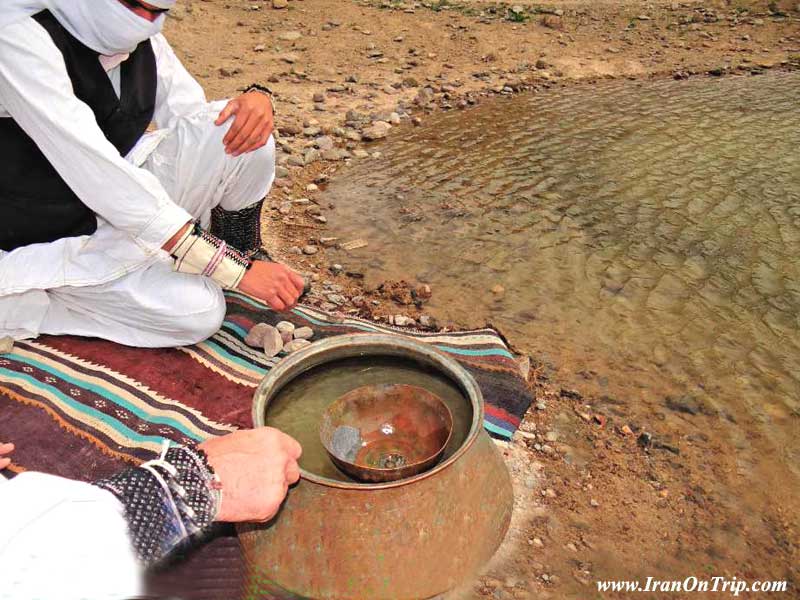
The Persians were using water clocks in 328 BC to ensure a just and exact distribution of water from qanats to their shareholders for agricultural irrigation. The use of water clocks in Iran, especially in Zeebad, dates back to 500 BC. Later they were also used to determine the exact holy days of pre-Islamic religions, such as the Yaldā (winter solstice), Tiregān (mid-summer) or Nowruz (spring equinox) - the shortest, longest, and equal-length days and nights of the years. The water clocks used in Iran were one of the most practical ancient tools for timing the yearly calendar.[citation needed][9] Water clocks, or Fenjaan, in Persia reached a level of accuracy comparable to today's standards of timekeeping. The fenjaan was the most accurate and commonly used timekeeping device for calculating the amount or the time that a farmer must take water from a qanat or well for irrigation, until it was replaced by more accurate current clocks.[citation needed] Persian water clocks were a practical and useful tool for the qanat's shareholders to calculate the length of time they could divert water to their farms. The qanat was the only water source for agriculture and irrigation, so that a just and fair water distribution was very important. Accordingly a fair and astute elder was elected to be the manager of the water clock, and at least two full-time managers were needed to control and observe the number of fenjaans and announce the exact time during the days and nights.
The fenjaan was a big pot full of water and a bowl with small hole in the center. When the bowl become full of water, it would sink into the pot, and the manager would empty the bowl and again put it on the top of the water in the pot. He would record the number of times the bowl sank by putting small stones into a jar.
The place where the clock was situated, and its managers, were collectively known as khaneh fenjaan. Usually this would be the top floor of a public house, with west- and east-facing windows to show the time of sunset and sunrise. There was also another time-keeping tool named a staryab or astrolabe, but it was mostly used for superstitious beliefs and was not practical for use as a farmers' calendar. The Zeebad Gonabad water clock was in use until 1965, when it was substituted by modern clocks.
Maintenance
The vertical shafts may be covered to minimize blown-in sand. The channels of qanats must be periodically inspected for erosion or cave-ins, cleaned of sand and mud and otherwise repaired. For safety, air flow must be assured before entry.
Restoration
Some damaged qanats have been restored. To be sustainable, restoration needs to take into account many nontechnical factors beginning with the process of selecting the qanat to be restored. In Syria, three sites were chosen based on a national inventory conducted in 2001. One of them, the Drasiah qanat of Dmeir, was completed in 2002. Selection criteria included the availability of a steady groundwater flow, social cohesion and willingness to contribute of the community using the qanat, and the existence of a functioning water-rights system.
Applications of qanats
Irrigation and drinking water supply
The primary applications of qanats are for irrigation, providing cattle with water, and drinking water supply. Other applications include cooling and ice storage.
Cooling
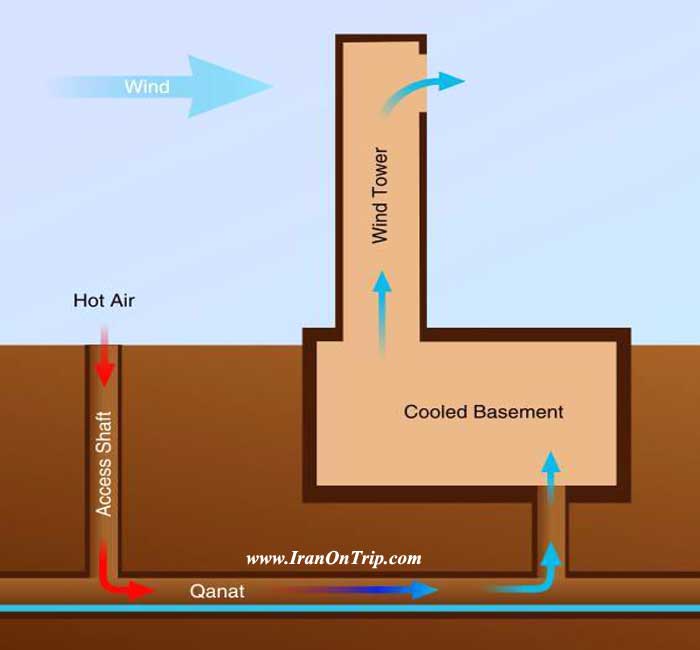
Qanats used in conjunction with a wind tower can provide cooling as well as a water supply. A wind tower is a chimney-like structure positioned above the house; of its four openings, the one opposite the wind direction is opened to move air out of the house. Incoming air is pulled from a qanat below the house. The air flow across the vertical shaft opening creates a lower pressure (see Bernoulli effect) and draws cool air up from the qanat tunnel, mixing with it. The air from the qanat is drawn into the tunnel at some distance away and is cooled both by contact with the cool tunnel walls/water and by the transfer of latent heat of evaporation as water evaporates into the air stream. In dry desert climates this can result in a greater than 15°C reduction in the air temperature coming from the qanat; the mixed air still feels dry, so the basement is cool and only comfortably moist (not damp). Wind tower and qanat cooling have been used in desert climates for over 1000 years.
Ice storage
By 400 BC Persian engineers had mastered the technique of storing ice in the middle of summer in the desert.
The ice could be brought in during the winters from nearby mountains. But in a more usual and sophisticated method they built a wall in the east–west direction near the yakhchal (ice pit). In winter, the qanat water would be channeled to the north side of the wall, whose shade made the water freeze more quickly, increasing the ice formed per winter day. Then the ice was stored in yakhchals — specially designed, naturally cooled refrigerators. A large underground space with thick insulated walls was connected to a qanat, and a system of windcatchers or wind towers was used to draw cool subterranean air up from the qanat to maintain temperatures inside the space at low levels, even during hot summer days. As a result, the ice melted slowly and was available year-round.
In the middle of the twentieth century, an estimated 50,000 qanats were in use in Iran, each commissioned and maintained by local users. Of these, only 25,000 remain in use as of 1980.One of the oldest and largest known qanats is in the Iranian city of Gonabad, and after 2,700 years still provides drinking and agricultural water to nearly 40,000 people. Its main well depth is more than 360 meters and its length is 45 kilometers. Yazd, Khorasan and Kerman are zones for known for their dependence on an extensive system of qanats.In traditional Persian architecture, a Kariz (کاریز) is a small Qanat, usually within a network inside an urban setting. The Kariz is the structure that distributes a qanat to its final destinations.
Your feedback is extremely valuable to us, and will be useful for others.
So let us to have your comments.
.....
.....
.....

.jpg)



























